FOOD SYSTEMS ACCOUNT FOR AT LEAST 15% OF ALL FOSSIL FUELS

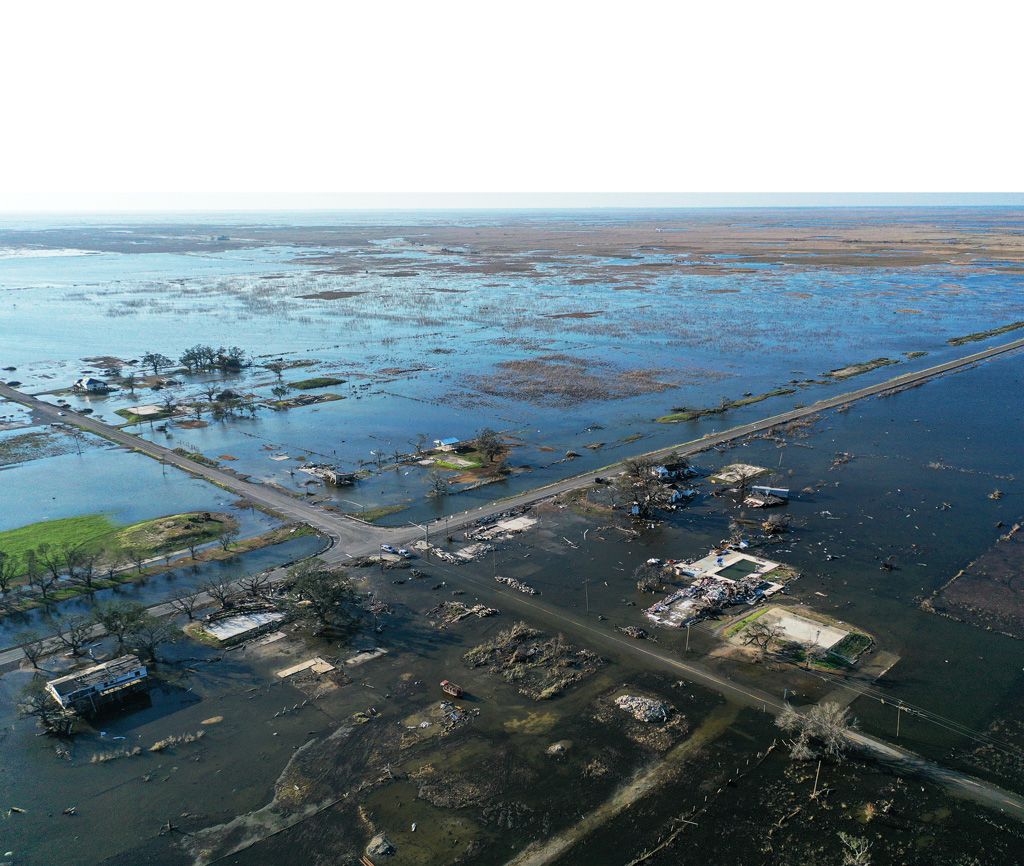
All climate impacts will intensify if the 1.5°C (2.7°F) threshold is breached — from flooding, drought, and heatwaves to crop failure and food scarcity to species loss and sea level rise — with dramatic effects on human health and well-being.
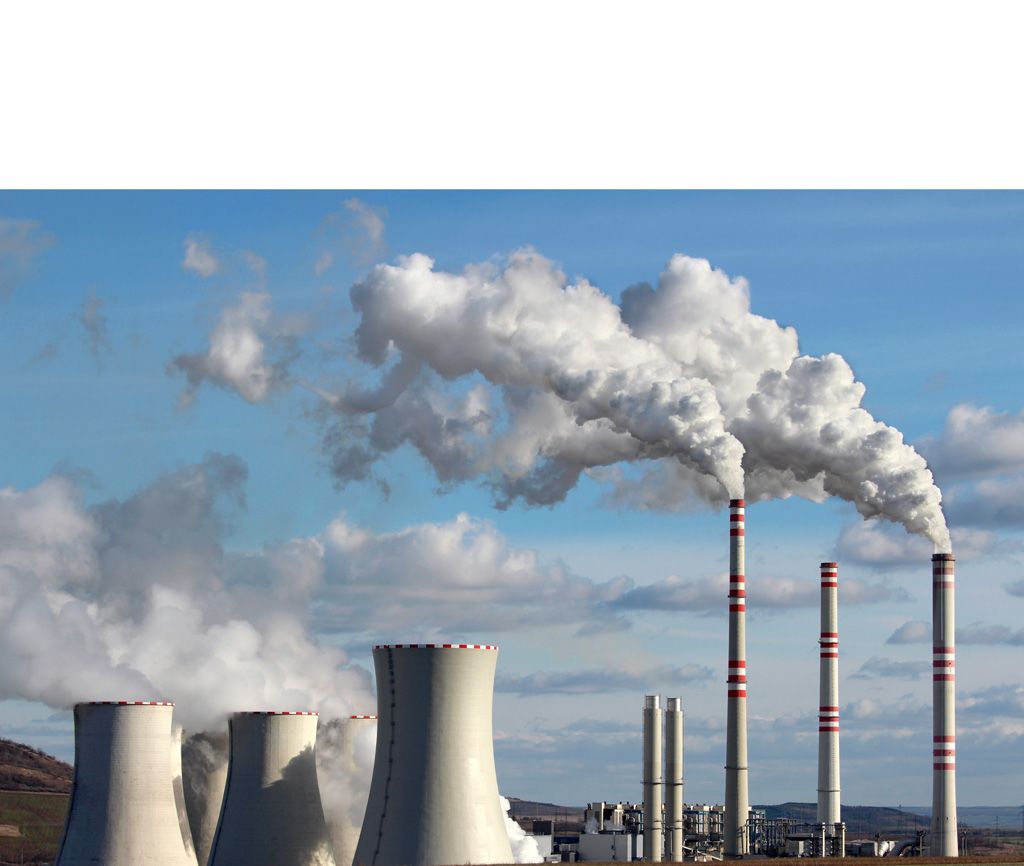
Every fraction of a degree counts, yet current food and energy policies put us on track to reach ~2.7°C (~4.7°F) by the end of the century. Fossil fuel use is by far the biggest driver of climate change. We need to radically reduce it now and phase it out almost completely by 2050 in order to reach net-zero emissions and prevent catastrophic climate change.
The science and economics are clear, but the political will is still lacking. Our modern economies and societies still run largely on fossil fuels, and there is a strong, powerful, and effective industry lobby working to delay action to end this. Countries whose economies gain significant revenue from fossil fuel production are often more reluctant than others to implement the policies needed.


FOOD SYSTEMS, ENERGY, AND CLIMATE ARE INTERTWINED
The Global Alliance for the Future of Food has previously documented the link between food systems and climate change. Food systems contribute to and are significantly affected by climate change. Food systems account for more than one-third of total greenhouse gas (GHG) emissions. Our 2022 analysis of countries’ climate pledges demonstrated how food systems not only contribute to and are significantly affected by climate change, but are also a crucial part of the solutions urgently needed to keep global warming below 1.5°C (2.7°F).
With food systems contributing to one-third of all the emissions driving the climate crisis, we highlight that changing the way we produce and consume food could reduce global GHG emissions by at least 10.3 gigatons a year, which is equivalent to 20% of the reduction needed by 2050 to stay below 1.5°C (2.7°F).
This report follows that analysis to show how the dependence of food systems on fossil fuels requires a collaborative and deliberate approach by both the energy sector and food sector.
The hosts of the 28th United Nations Conference of the Parties on Climate Change (COP28), the United Arab Emirates (UAE), have said they will place an emphasis on sustainable agriculture and food production at the meeting in December. This is welcome, but any action on food must be explicitly linked to and include efforts to phase out fossil fuel production. With the latest UN numbers showing that around 735 million people globally still face hunger and 3.1 billion cannot afford and/or do not have access to healthy diets, the need to reform food systems to enhance food security, improve nutrition, preserve nature, and help stop climate change has never been clearer.
We cannot transform food systems without addressing fossil fuel consumption, and we will not be able to phase out fossil fuel and stop catastrophic climate change without changing food systems.
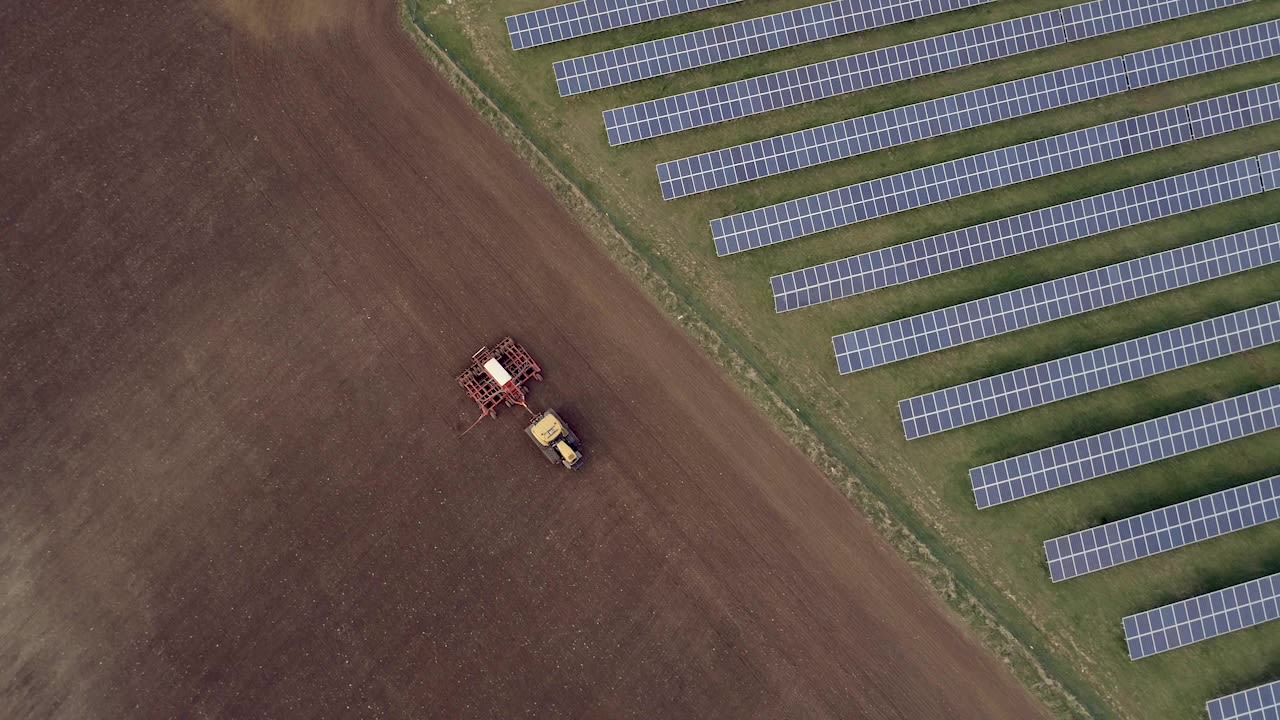
THE INTERDEPENDENCE OF FOOD AND ENERGY SYSTEMS
Industrial food systems are intertwined with the fossil fuel industry; they are highly energy intensive and dependent on fossil fuels across the value chain. We’ve calculated that food systems currently account for at least 15% of global fossil fuel use annually, driving as many emissions as all EU countries and Russia combined.
With business-as-usual food production and processing driving the demand for energy-intensive and ultra-processed foods, fossil fuel use will increase unless we drastically transform food systems to break the link between food and fossil fuels.
The dangers of this dependence have been highlighted throughout 2022–2023, with the war in Ukraine having both a direct and indirect effect on food supplies and prices. Direct, because Ukraine and Russia have been exporting less grain, cooking oil, and fertilizer, and indirect as a result of higher oil prices affecting transport and fertilizer costs in particular. Reducing this dependence on centralized exports of energy- and fossil fuel–intensive commodities would thus enhance global food security.
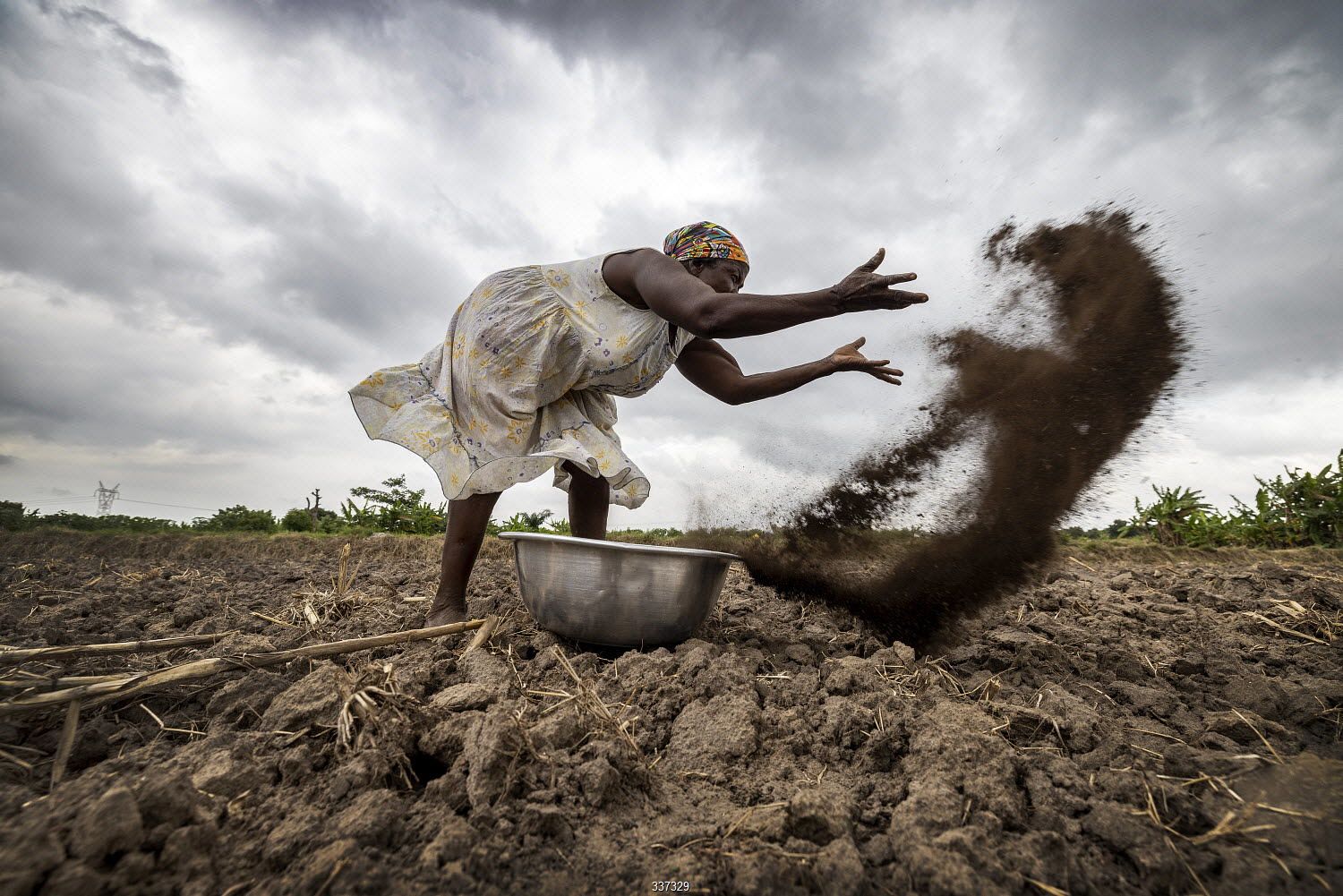
For Eva, a farmer in Ghana, fertilizer prices have risen 300% since 2022 due in part to the shortages and price spikes caused by the war in Ukraine and to the fertilizer industry’s exploitation of the crisis to increase prices to customers. She now spreads locally produced organic manure and compost on her field.
For Eva, a farmer in Ghana, fertilizer prices have risen 300% since 2022 due in part to the shortages and price spikes caused by the war in Ukraine and to the fertilizer industry’s exploitation of the crisis to increase prices to customers. She now spreads locally produced organic manure and compost on her field.
Fossil fuels play a crucial role in the production of food throughout the four stages of the value chain:
- Input production;
- Land use and agricultural production;
- Processing and packaging; and
- Retail, consumption, and waste.
Energy is used to produce and package food, power machinery and equipment, fuel transportation systems, and for storage and cooking.
The vast majority of the fossil fuel consumption is in the processing and packaging stage, as well as in retail, consumption, and waste.
Energy intensity in food systems is also growing due to: increased mechanization; growing use of fossil fuel–based inputs, including pesticides and fertilizers; globalized supply chains; growing demand for meat, dairy, and ultra-processed foods; and, to some extent, new food trends such as alternative proteins. We need to decouple food production from fossil fuel use if we are to stop catastrophic climate change.
INPUT PRODUCTION
5% of global energy use across the food value chain.
The manufacturing of fertilizers is the most energy-intensive and fossil fuel–dependent stage. The most common fertilizer, synthetic nitrogen, requires an extremely energy-intensive process that involves high temperatures and pressures. For example, according to the Centre for International Environment Information (CIEL), producing the ammonia (NH₃) on which nitrogen fertilizers are based releases an estimated 450 million tons of carbon dioxide (CO2) per year — equivalent to the total energy system emissions of South Africa. The FAO projects that nitrogen fertilizer use could increase by another 50% by 2050. Furthermore, the International Energy Agency (IEA) projects ammonia production to grow by nearly 40% by 2050 based on current economic trends, with over half of fossil gas consumption going toward producing hydrogen, the key ingredient in ammonia.
Actors in this stage reap the highest rewards while avoiding the immediate negative consequences felt by actors further down the value chain.
LAND USE AND AGRICULTURAL PRODUCTION
15%* of global energy use across the food value chain.
Communities and small-scale producers disproportionately bear the burden of climate impacts, extractive land use practices, and unsustainable resource use. Meanwhile, most of the profits in the value chain accrue to the input manufacturers, distributors, and large producers and traders.
PROCESSING AND PACKAGING
42% of global energy use across the food value chain.
This stage consumes a lot of energy because it relies on energy-intensive equipment, refrigeration systems, packaging, and transport to ensure the preservation of food from farm to table.
The energy intensity of this stage is increasing as supply chains get longer, requiring increased use of packaging and stricter processing requirements.
RETAIL, CONSUMPTION, AND WASTE
38% of global energy use across the food value chain.
An estimated one-third of globally produced food is lost or wasted. In high-income countries, retail is particularly energy intensive due to higher consumption of processed foods and associated refrigeration requirements.
The distance that our food travels has increased by a quarter over the last two decades, escalating emissions. However, the rate of electrification emissions could fall, particularly in developed countries.
ENERGY IS USED THROUGHOUT FOOD SYSTEMS:
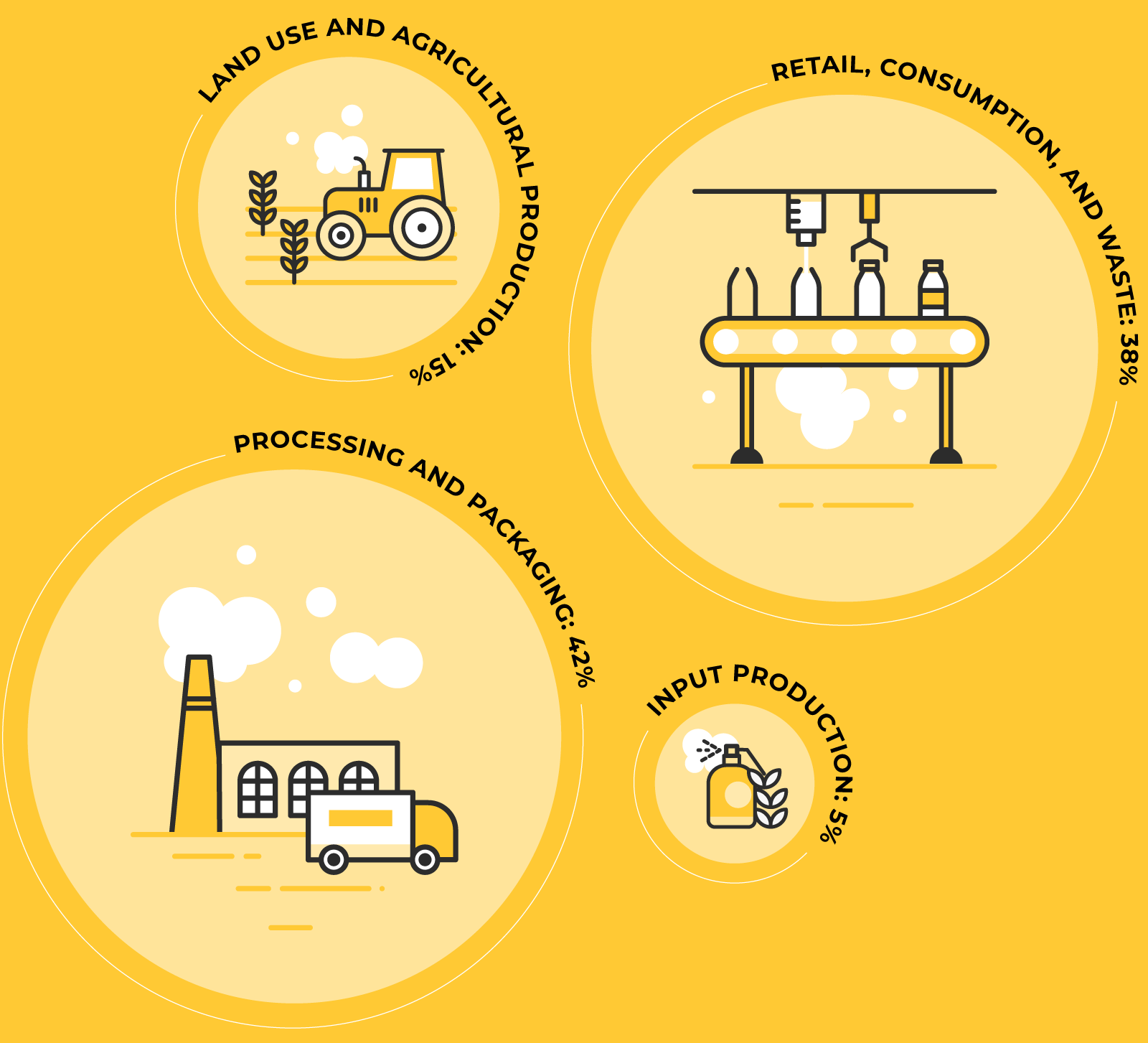
INPUT PRODUCTION
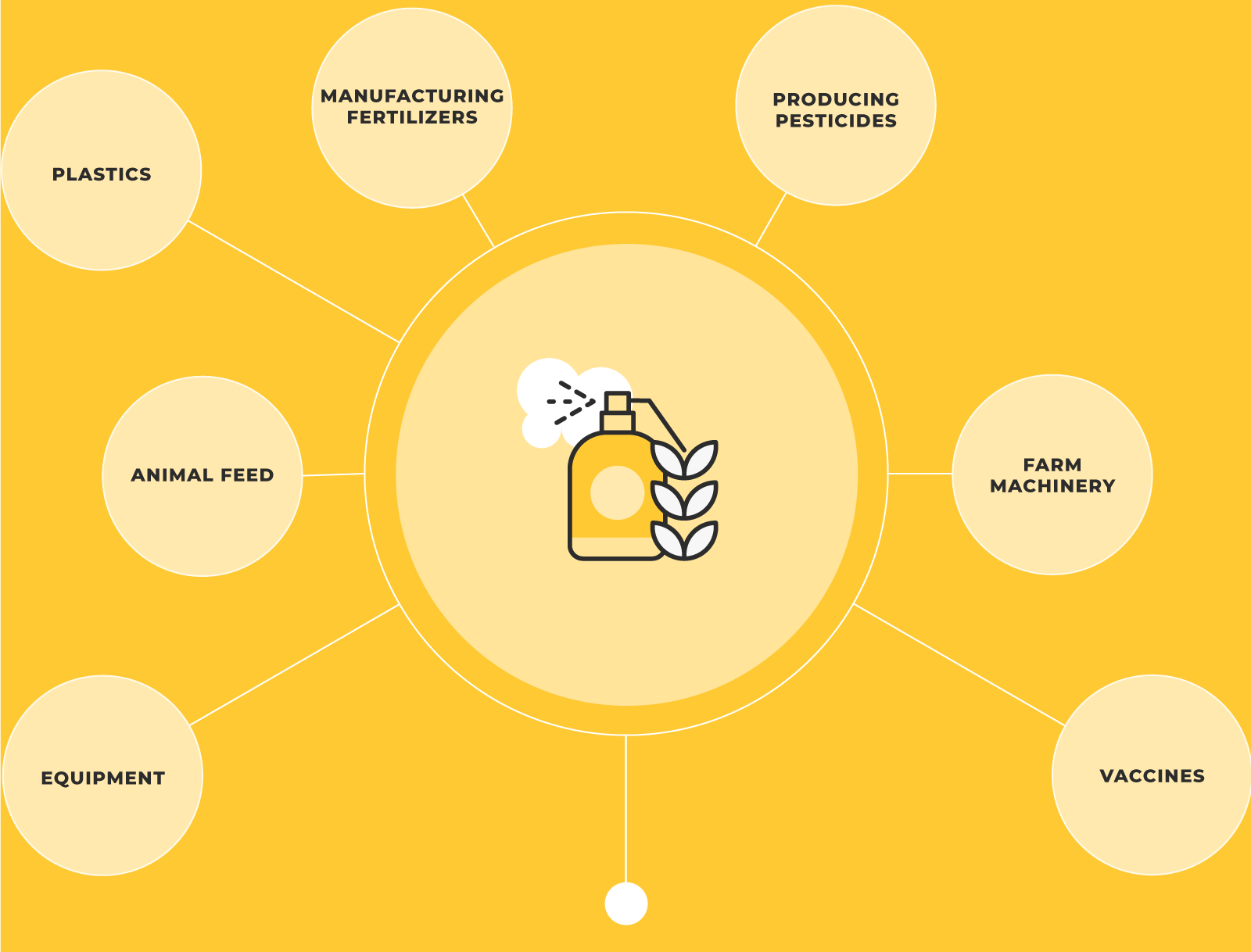
5% of global energy use across the food value chain.
The manufacturing of fertilizers is the most energy-intensive and fossil fuel–dependent stage. The most common fertilizer, synthetic nitrogen, requires an extremely energy-intensive process that involves high temperatures and pressures. For example, according to the Centre for International Environment Information (CIEL), producing the ammonia (NH₃) on which nitrogen fertilizers are based releases an estimated 450 million tons of carbon dioxide (CO2) per year — equivalent to the total energy system emissions of South Africa. The FAO projects that nitrogen fertilizer use could increase by another 50% by 2050. Furthermore, the International Energy Agency (IEA) projects ammonia production to grow by nearly 40% by 2050 based on current economic trends, with over half of fossil gas consumption going toward producing hydrogen, the key ingredient in ammonia.
Actors in this stage reap the highest rewards while avoiding the immediate negative consequences felt by actors further down the value chain.
LAND USE AND AGRICULTURAL PRODUCTION
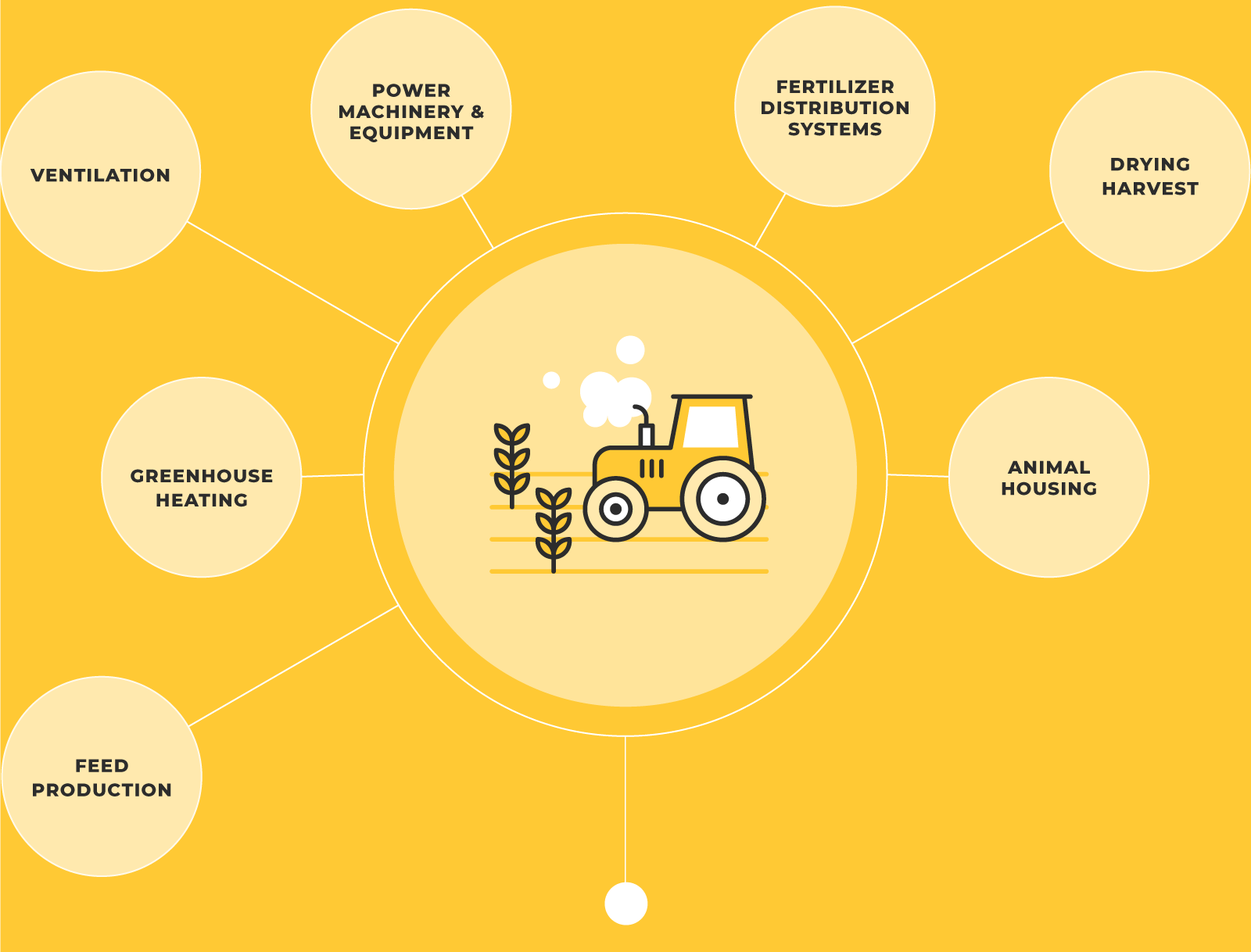
15%* of global energy use across the food value chain.
Communities and small-scale producers disproportionately bear the burden of climate impacts, extractive land use practices, and unsustainable resource use. Meanwhile, most of the profits in the value chain accrue to the input manufacturers, distributors, and large producers and traders.
PROCESSING AND PACKAGING
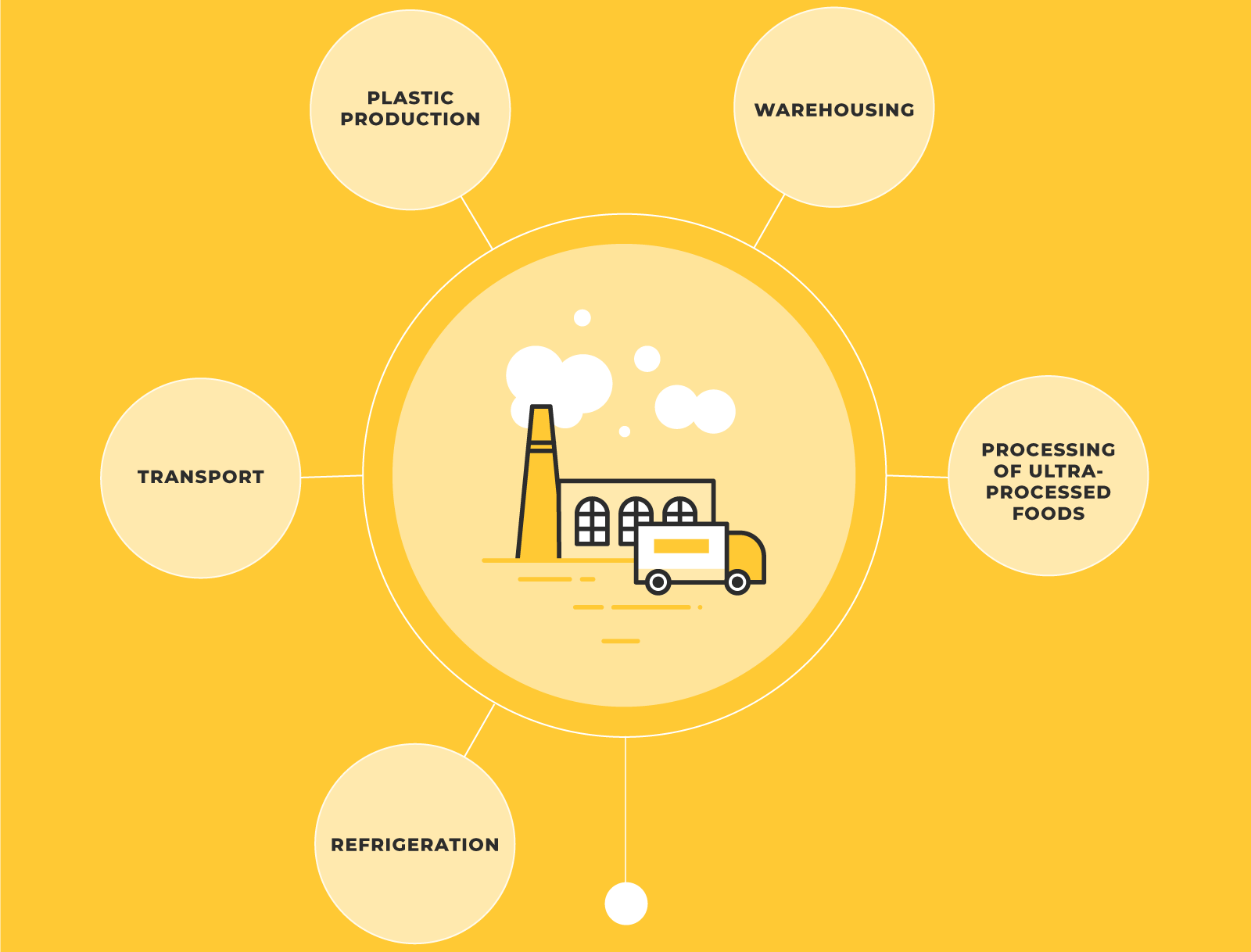
42% of global energy use across the food value chain.
This stage consumes a lot of energy because it relies on energy-intensive equipment, refrigeration systems, packaging, and transport to ensure the preservation of food from farm to table.
The energy intensity of this stage is increasing as supply chains get longer, requiring increased use of packaging and stricter processing requirements.
RETAIL, CONSUMPTION, AND WASTE
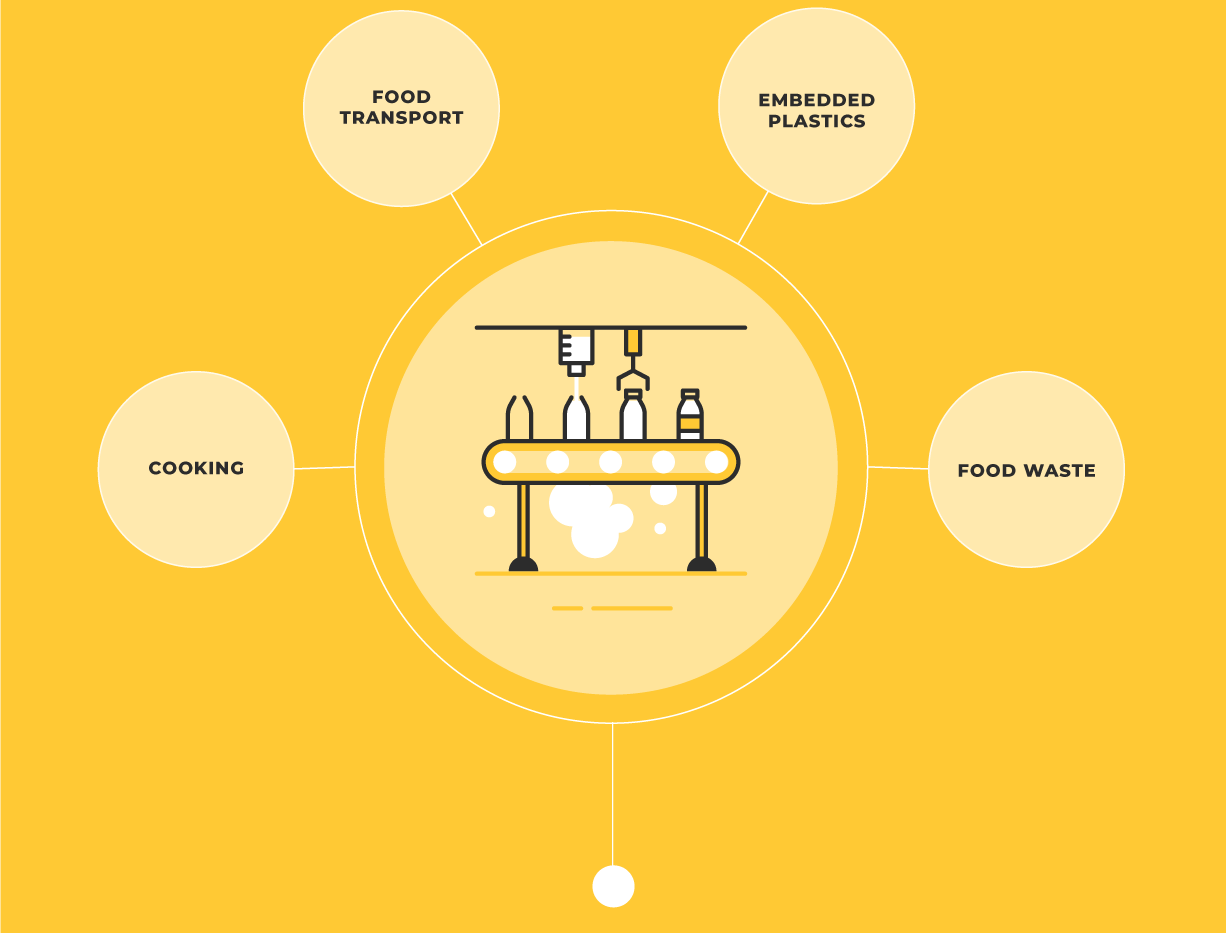
38% of global energy use across the food value chain.
An estimated one-third of globally produced food is lost or wasted. In high-income countries, retail is particularly energy intensive due to higher consumption of processed foods and associated refrigeration requirements.
The distance that our food travels has increased by a quarter over the last two decades, escalating emissions. However, the rate of electrification emissions could fall, particularly in developed countries.
FOOD TRENDS ARE DRIVING INCREASED ENERGY USE

Our calculations based on two studies found that the production of ultra-processed yogurt is 10 times more energy-intensive than fresh milk.
Our calculations based on two studies found that the production of ultra-processed yogurt is 10 times more energy-intensive than fresh milk.
Ultra-processed products such as snacks, drinks, and ready-made meals are dominant in high-income countries, and their consumption is now rapidly increasing in low- and middle-income countries as well. Currently, a high proportion of the energy requirement for these processed foods is from fossil fuels — although, in the future, this energy could be produced from renewable sources as renewable energy increasingly becomes more cost-effective. Our calculations based on two studies1, 2 found ultra-processed strawberry yogurt to be 10 times more energy intensive than unprocessed milk. The uptick in the consumption of ultra-processed foods implies increased demand for fossil fuels in the food system use over time.
For example, ultra-processed dairy is 10 times more energy intensive than fresh milk*
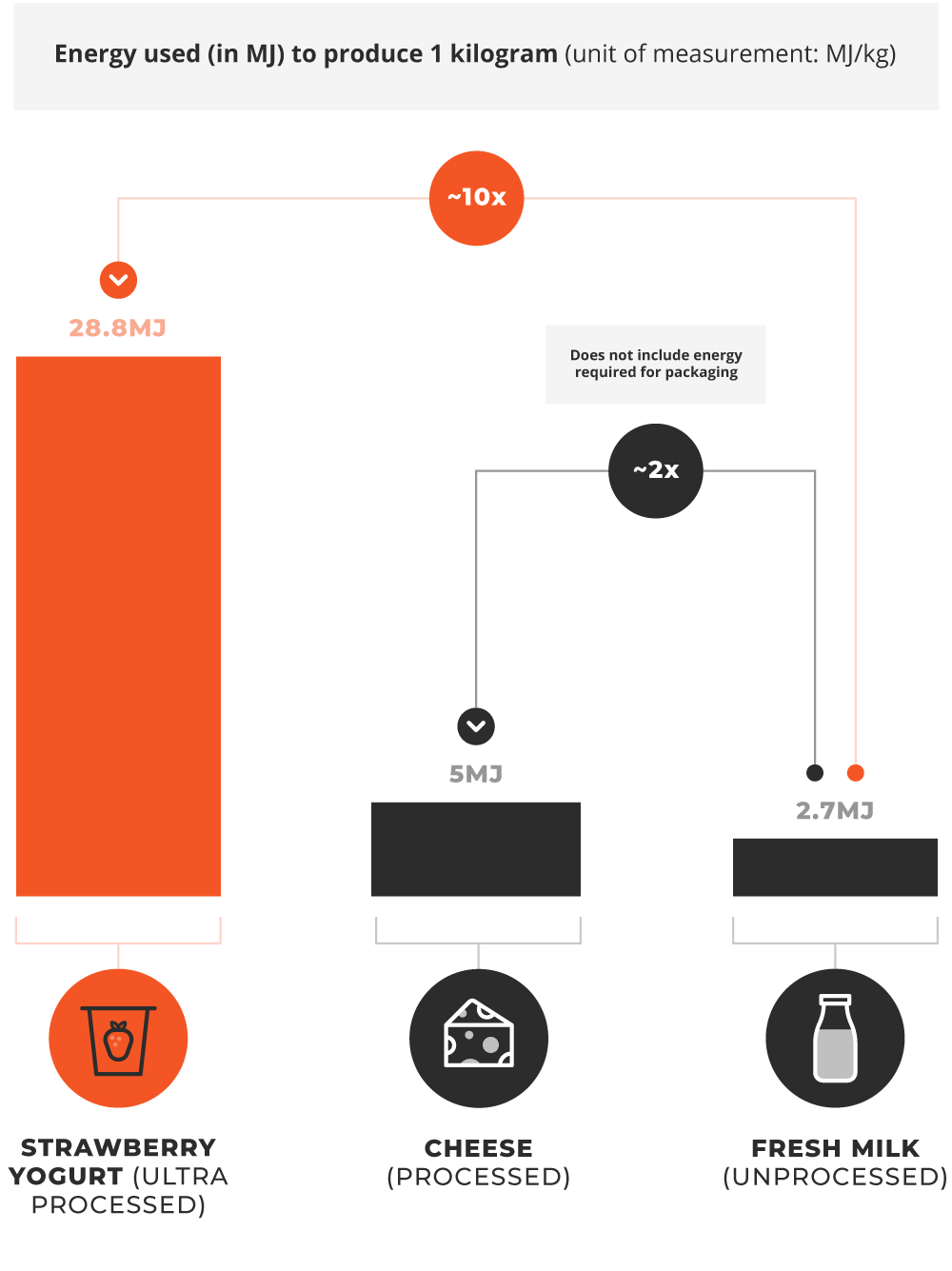
Similarly, while proponents of alternative meats and proteins argue these products reduce land and water footprints relative to industrial-scale meat production, some of these alternatives are still very energy intensive. One study has shown that lab-grown meat requires up to 6 times more energy compared to chicken and other less-processed alternatives. However, the evidence on the carbon footprint and lifecycle impact of lab-grown meat compared to animal meat remains disputed.
In general, alternative proteins may improve individual sustainability indicators when compared with industrially produced equivalents, but the evidence is limited and speculative for lab-grown meat. There are also open questions on the potential impact of the alternative-protein industry on further concentration of power in food systems, given the large research and development budgets required to produce these proteins. The industrialization that comes with alternative protein could undermine resilience, jeopardizing the livelihoods of millions of food producers.
Furthermore, each kilogram of lab-grown meat has a lower protein content (10 to 25%) compared to chicken (31%). This implies that, from a nutritional perspective, more lab-grown meat would need to be produced and consumed to obtain the same amount of protein, resulting in higher energy intensiveness. A holistic understanding of the implications and trade-offs of alternative meats and protein is important to mitigate unintended consequences.
Lab-grown protein is the most energy-intensive form of alternative meats and proteins.*
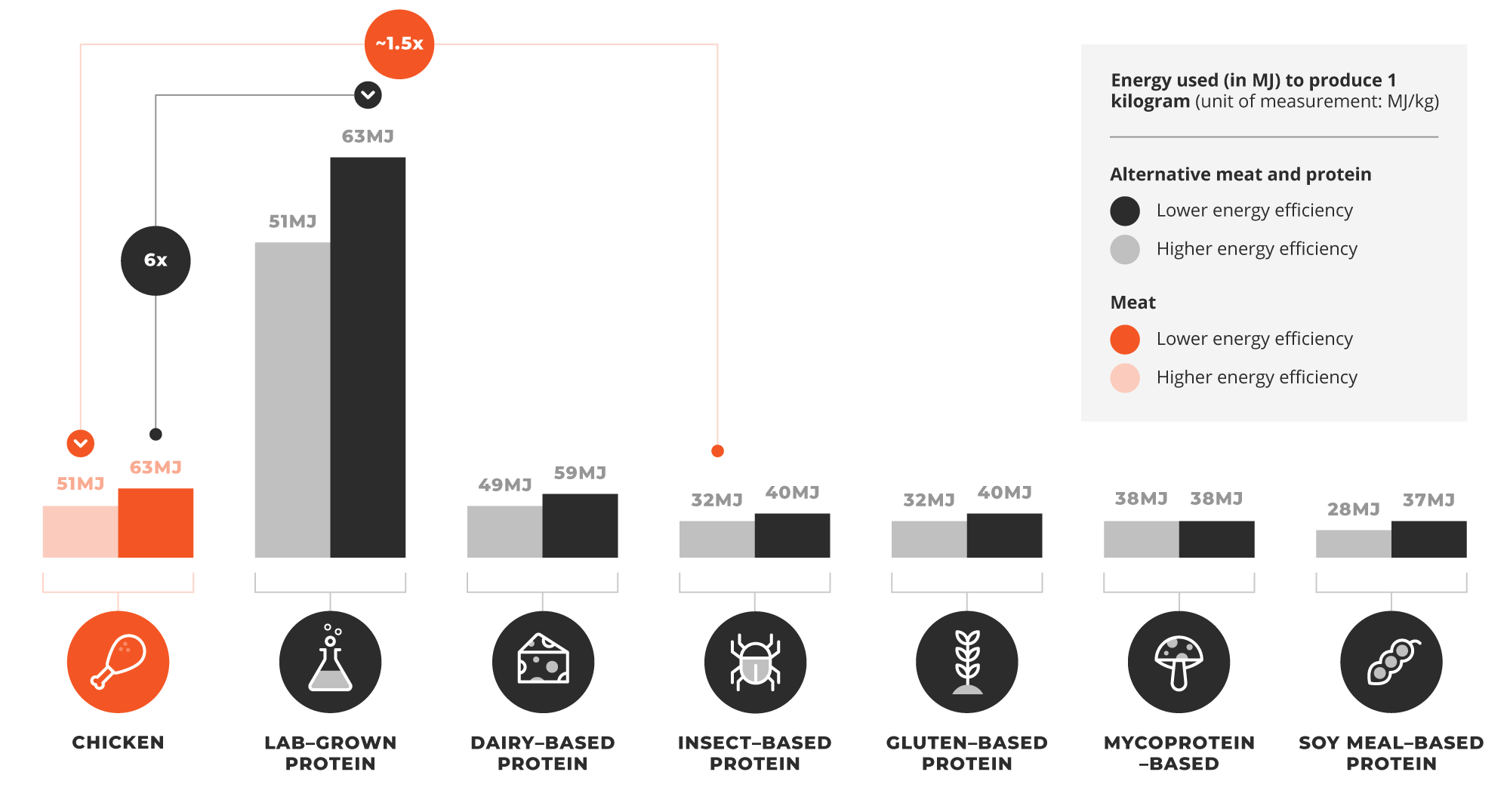
*Smetana et al., Meat Alternatives: Life Cycle Assessment of Most Known Meat Substitutes, 2015.
*Smetana et al., Meat Alternatives: Life Cycle Assessment of Most Known Meat Substitutes, 2015.
VESTED INTERESTS ARE BARRIERS TO FOSSIL FUEL PHASE-OUT IN FOOD SYSTEMS
As demand for fossil fuels for transport, power, and heating declines due to electrification and demand-reduction measures, companies are investing significantly in petrochemicals to produce plastics and agrochemicals. Agrochemicals (including fertilizers and pesticides) and plastics (including for packaging) are key to sustaining some industrial food systems activities, and the fossil fuel industry is banking on their growth to sustain profits.
The growing petrochemicals market accounted for 14% of oil production in 2018, and 8% of gas production.
Food-related plastics and fertilizers together represent approximately 40% of petrochemical products.
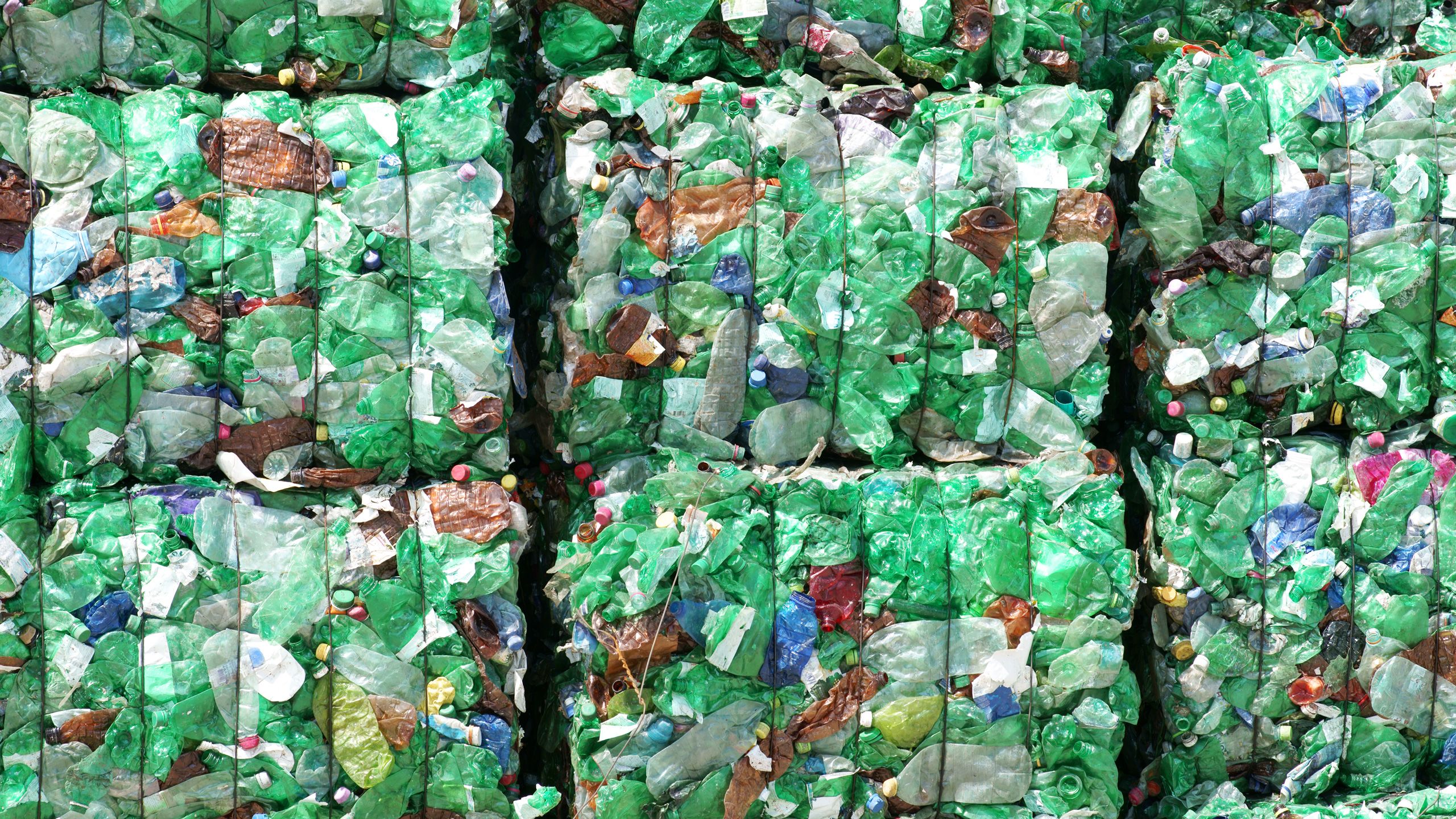
The International Energy Agency (IEA) estimates that petrochemicals will drive nearly half of oil demand growth by mid-century, outstripping sectors like aviation and shipping, with 40% of that demand from food-related plastics and fertilizers.

Recognizing this potential, the fossil fuel industry in the United States alone was projected to spend over USD 164 billion from 2016 to 2023 on constructing new facilities and expanding existing projects within the petrochemical industry.
Similarly, in the UAE, major producers have announced USD 150 billion in investments over the next 5 years to accelerate oil and gas production — some of which is likely aimed at meeting growing demand for plastics.
The top petrochemical, plastics, and agrochemical companies are often part of the same corporate structures.
Many agri-food sectors are dominated by four to six firms with vested interests in maintaining the status quo of agriculture inputs and markets. These companies possess a vested interest in promoting and perpetuating fossil fuel– and chemical-dependent, extractive industrial food systems and make significant political contributions to ensure their influence.
FOOD SYSTEMS ARE MAKERS OF ENERGY, NOT JUST TAKERS
As well as consuming energy, food systems produce energy in the form of biofuels (e.g., corn, maize), biomaterials (e.g., livestock manure, edible food waste), and on-farm energy production (e.g., agrivoltaics, small-scale hydropower).
However, this energy production is not always without undesirable side effects. Some renewable energy projects can have a negative impact on the environment and local communities, and production of biofuels can take land away from food production.
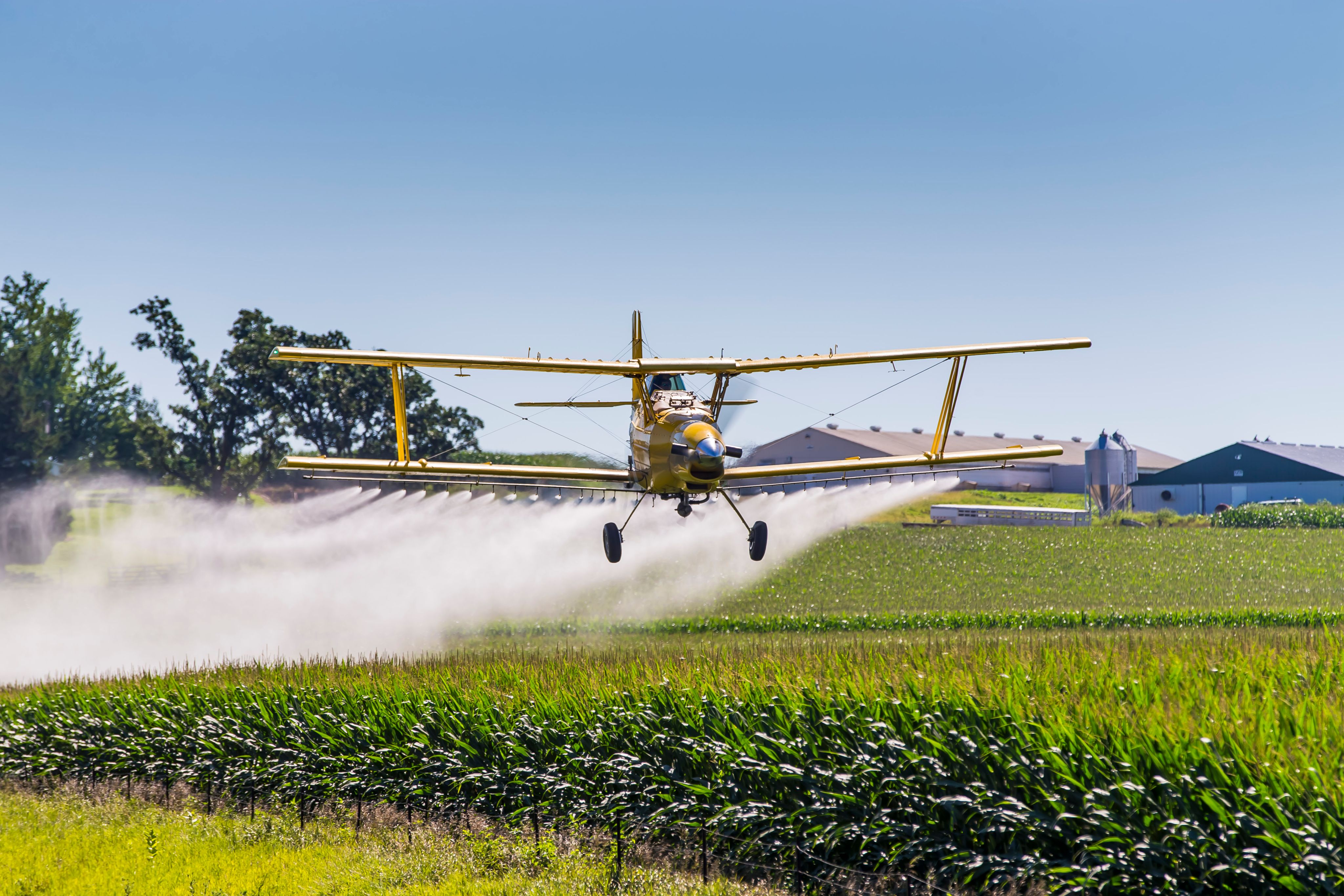
Research by the U.S. Department of Energy has found that corn-based ethanol is at least 24% more carbon-intensive than gasoline, making ethanol worse for the climate than gasoline.
Research by the U.S. Department of Energy has found that corn-based ethanol is at least 24% more carbon-intensive than gasoline, making ethanol worse for the climate than gasoline.
Fiscal policies have also shaped and incentivized biofuel production, with some significant environmental consequences when biofuels are produced on a large scale. Tax credits, subsidies, and loans have increased the production of biofuel feedstocks such as soy and corn. Subsidies for biogas production also incentivize the growth of the industrial livestock industry, with the development of manure-to-energy projects. One study estimated that the European Union’s palm biodiesel policies caused the loss of a tropical forest area the size of the Netherlands between 2009 and 2019.
Other potential drawbacks from the growth of the biofuel industry include changes to land use patterns that increase GHG emissions, pressure on water resources, air and water pollution, and increased food costs.
Fundamentally, food and energy both rely on natural resources of land and water — requiring vast tracts of land for cultivation or infrastructure, and using water for irrigation, extraction in fracking, and energy generation.
Crops also remove carbon dioxide from the atmosphere and sequester this carbon into the soil, although the potential varies by crop and needs to be further studied.
Agricultural lands are thus major carbon sinks. According to the OECD, net soil carbon sequestration on agricultural lands could offset 4% of annual global human-induced GHG emissions over the rest of the century and make an important contribution to meeting the targets of the Paris Agreement. This does not mean that agriculture should become an offset for fossil fuel producers. Agriculture is part of the solution but not a replacement for the need for fossil fuel phase-out.
This interconnectedness gives rise to complex interactions, both trade-offs and synergies. For example, allocating finite resources such as land and water to one sector can limit their availability for another. But synergies and optimal solutions with multiple benefits can be found by engaging equitably with all actors, especially those most impacted by the resource allocation and policy decisions. This will be key to charting our way to a sustainable, equitable, and low-carbon future.
UNLOCKING TRANSFORMATION
Urgent decarbonization of our food systems is essential, via a rapid shift away from fossil fuels. The interactions and co-dependencies of the food and energy systems do not receive the attention they deserve; nor is there enough focus on the potential dividends of collaboration, including for climate change, biodiversity, land and water pollution, livelihoods, food and energy security, and nutrition.
To seize multiple opportunities and avert a deeper crisis than the world faces already, we need to identify and prioritize actions that will help transform both the energy and food sectors, increase resilience, reduce price volatility, enhance food security and nutrition, contribute to a cleaner and healthier environment, and improve livelihoods while also reducing emissions and enabling the low-carbon transition.
Agriculture and food systems don’t just need to reduce fossil fuel consumption, they need to become less energy intensive overall.
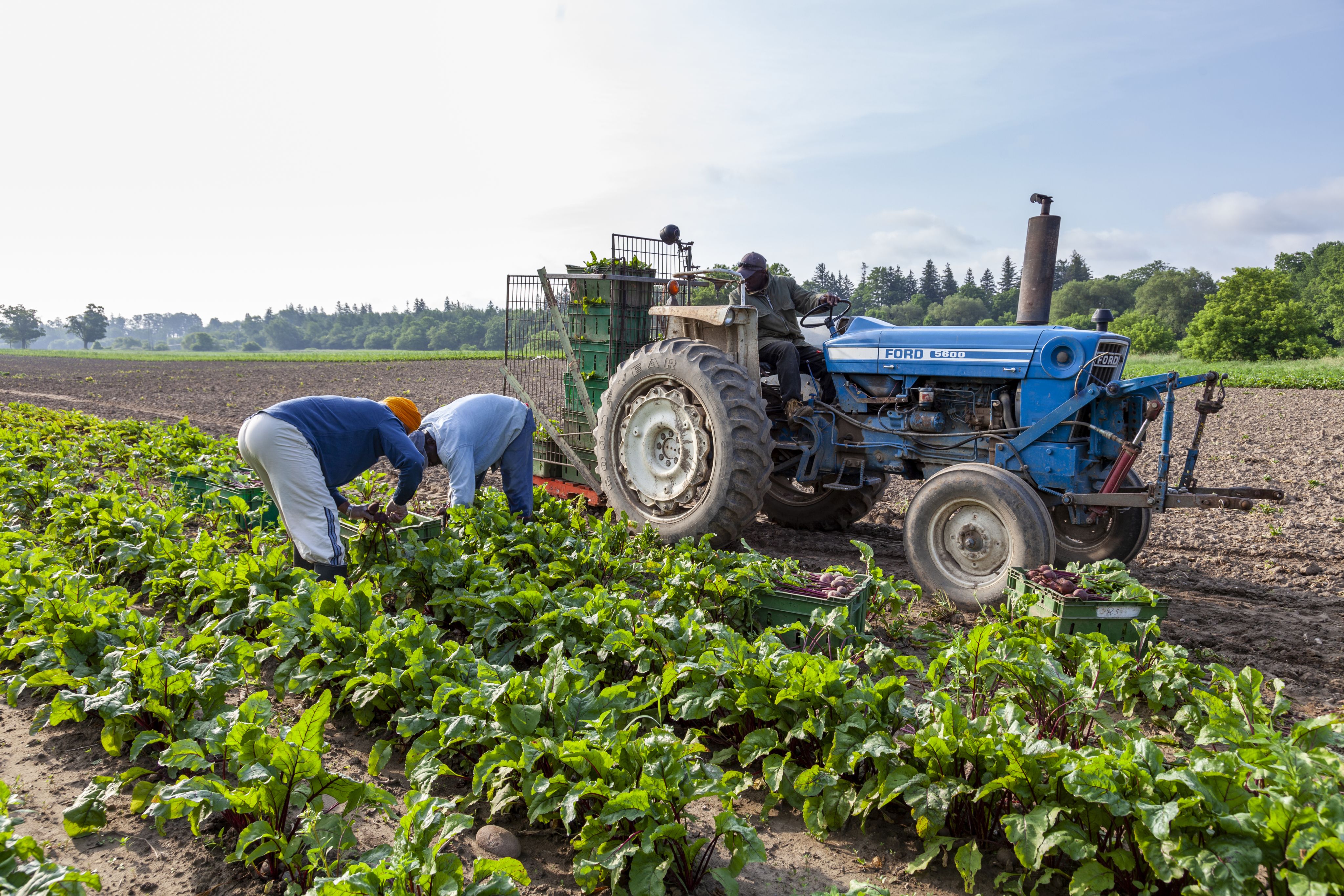
This same shift needs to happen across all sectors in order to achieve net-zero targets. We cannot simply replace one form of energy with another; we must reduce energy use overall.
Just as we need to fundamentally transform industrial food systems, energy systems based on renewable energy rather than fossil fuels also require fundamental changes to grid and storage infrastructure that can integrate the diverse characteristics associated with different sources of renewable energy (e.g., solar availability, wind speeds, hydro availability). Decarbonized energy systems require us to reduce the demand for energy as well as shift when and how we use it.
Meanwhile, so-called “green” alternatives or techno-fixes, such as green hydrogen or genetically modified crops, can lock in negative practices. Genetically engineered crops increase dependence on synthetic fertilizers and pesticides as well as adversely impact biodiversity and further exacerbate concentration of power and profit among a limited number of global companies. Green hydrogen specifically may have a modest role to play in hard-to-abate sectors such as steel and chemicals, but those applications are limited and often overstated. Moreover, many energy companies are looking to green hydrogen to decarbonize their oil and gas operations to boost their longevity.
RECOMMENDATION TO WEAN OUR FOOD SYSTEMS OFF FOSSIL FUELS
By interviewing key stakeholders, we have identified the following high-impact, no-regret opportunities for greater collaboration on the food–energy nexus.
PHASE OUT FOSSIL FUEL–BASED AGROCHEMICALS, AND TRANSITION TO REGENERATIVE AND AGROECOLOGICAL APPROACHES:
Widespread overuse of fossil fuel–based agrochemicals and limited focus on eliminating their use in food production calls for an urgent shift to agroecological production systems that are less reliant on external inputs and replacing residual need with environmentally friendly inputs such as bio-fertilizers and through on-farm practices for pest management. Shifting to low-carbon practices such as agroecology and regenerative approaches will enable the decoupling of food production from GHG emissions.
REVIEW FISCAL POLICIES TO COUNTER NEGATIVE EXTERNALITIES OF ENERGY PRODUCTION:
There is a need to review existing electricity subsidies for biogas production that unintentionally incentivize the growth of the industrial livestock industry, as well as tax credits, subsidies, and loans to increase production of biofuel feedstocks such as soy and corn.
SHIFT TO RENEWABLES-BASED COOLING, HEATING, AND DRYING TECHNOLOGIES:
Renewables-based technologies for cooling, heating, and drying agricultural products can potentially bring about multiple co-benefits with few resources in a short timeframe.
SHIFT TO RENEWABLE ENERGY FOR FOOD PROCESSING AND TRANSPORT:
Work with food-processing companies to assess and minimize energy use, as well as shift to less-processed foods to reduce emissions and associated environmental implications, and to improve health outcomes. Currently, some food conglomerates are relying on the decarbonization of the energy grid to facilitate their transition.
ENSURE HEALTHY, SUSTAINABLE, AND JUST FOOD ENVIRONMENTS THAT SUPPORT PLANT-RICH DIETS AND MINIMALLY PROCESSED FOODS:
By shifting to more minimally processed plant-rich diets, particularly where meat and saturated-fat consumption is high or growing at levels that risk human and/or planetary health, there is potential to reduce the energy intensity of our food systems and diet-related GHG emissions by 49% while generating substantial health co-benefits. Consumer groups, the public health community, and even countries have called for action. For example, Mexico and Denmark have promoted new dietary guidelines that emphasize the need to reduce beef and dairy consumption. A comprehensive roadmap to creating systemic change across different geographies reflecting diverse cultural food preferences and issues of over-consumption and food security is required.
TRACK AND ADDRESS CORPORATE CONSOLIDATION IN THE AGROCHEMICAL AND FOOD INDUSTRIES WHILE ACTIVELY SUPPORTING A JUST TRANSITION THROUGH MORE INCLUSIVE AND EQUITABLE GOVERNANCE AND DECISION-MAKING:
With a trend of consolidation in the processing industry through food conglomerates, as well as between the top petrochemical, plastics, and agrochemical companies, governments must address the impacts of this consolidation. They must also enable new forms of participatory and equitable governance to counter the vested interests in promoting and perpetuating fossil fuel– and chemical-dependent, extractive industrial food systems and highly processed foods.
TAKING ACTION
Policymakers, private sector actors, investors, donors, funders, civil society, and academics all need to play a role in fostering greater collaboration at the food–energy nexus. For example:
PHILANTHROPIES AND DONORS
Funders and conveners
Philanthropies and donors can initiate a series of dialogues around food and energy, and fund action opportunities emerging from these, including awareness-raising initiatives and campaigns and ensuring affected communities are being heard in these discussions.
Expertise:
- Bringing together different actors
- Financing new initiatives
Tools:
- Finances to support events, research, pilot initiatives
- Strong connections across sectors and stakeholders
- De-risk transition process, support early action
Recommendations:
- Convene stakeholders
- Fund awareness-raising
- Fund ambitious transition away from fossil fuels
POLICYMAKERS AND THE PUBLIC SECTOR
Key decision makers, investors, and implementers
Policymakers can actively support and promote healthy, sustainable, and just food environments that incentivize consumers to make better choices. They can also support policies that phase out the use of any unnecessary fossil fuel inputs into food systems, such as single-use plastic and fertilizers, while ensuring that these phase-outs are part of a just transition that does not disproportionately affect lower-income producers and consumers. The replacement of inputs with more sustainable alternatives must consider any challenges regarding risks, such as increasing food loss and waste.
Policymakers and public sector investors can act on negative externalities of energy production through a review of existing policies, legislation, and regulations. They can also fund research and social innovation.
Expertise:
- Balancing the priorities and trade-offs of differing stakeholder views
Tools:
- Platforms to elevate messages for public awareness
- Tax and subsidy schemes to create incentives
- Regulations and legislations to ensure standards
- Policies and programs to support implementation
Recommendations:
- Act on existing negative externalities
- Encourage energy and food ministry collaboration
- Fund research and social innovation
CIVIL SOCIETY AND PRODUCERS
Educators and leaders
Civil society and producers can focus on raising awareness through research, communications, and advocacy.
Expertise:
- Identifying and elevating issues through research and advocacy
Tools:
- Self organization and development
- Access to and understanding of people on the ground, in marginalized communities, etc.
Recommendations:
- Raise awareness
- Sensitize stakeholders
- Build alliances and gather input from a wide variety of stakeholders
PRIVATE SECTOR COMPANIES AND INVESTORS
Investors, innovators, and implementers
Private sector companies and investors can finance and scale innovations that reduce energy intensity in food systems and transport. Private sector organizations can also actively support and promote healthy, sustainable, and just food environments that incentivize consumers in making better choices.
Expertise:
- Understanding market and user requirements for widely adopted solutions
Tools:
- Capacity to promote and support innovation
- Widespread reach (i.e., large customer base, users) to test and encourage adoption
Recommendations:
- Invest in the sustainable transition of food
- Drive implementation and scaling of solutions
ACADEMICS
Frontiers of knowledge
Academics can conduct additional research on new topics and approaches such as researching energy use and emissions in fisheries and looking into how fossil fuel infrastructure can be repurposed. Academics can also analyze the energy use in intensive livestock production and the sustainability of alternative protein sources.
These are a few examples from the long list of research topics identified by the stakeholders we interviewed that could help foster greater collaboration on the food–energy nexus.
Expertise:
- Conducting research on new topics and approaches
Tools:
- Primary and secondary data
- Interdisciplinary approaches and collaborations
- Platforms to communicate research
Recommendations:
- Conduct additional research
- Pilot new interventions
TIME TO RADICALLY CHANGE OUR FOOD AND ENERGY SYSTEMS
The bottom line is that continuing business-as-usual with incremental shifts will not be enough to achieve the radical energy and food systems transitions needed to prevent catastrophic climate change and solve health and nutrition crises. Even if all governments delivered on their 2030 climate pledges (known as Nationally Determined Contributions or NDCs), fossil fuel use in our food system would still exceed the 1.5°C (2.7°F) carbon budget by 2037.
We need to dramatically change the way food is produced and consumed, and get off the unsustainable path of fossil fuel dependency. Shifting to low-carbon practices such as agroecology, regenerative approaches, sustainable diets, and localized value chains will enable the decoupling of food production from GHG emissions and realize a raft of other benefits for people’s health, livelihoods, and the environment. This will require collaboration and a willingness on the part of stakeholders across sectors to cooperate.
At a time of surging fossil fuel and food prices, deepening geopolitical divisions, and an escalating climate crisis, the case for action has never been clearer.
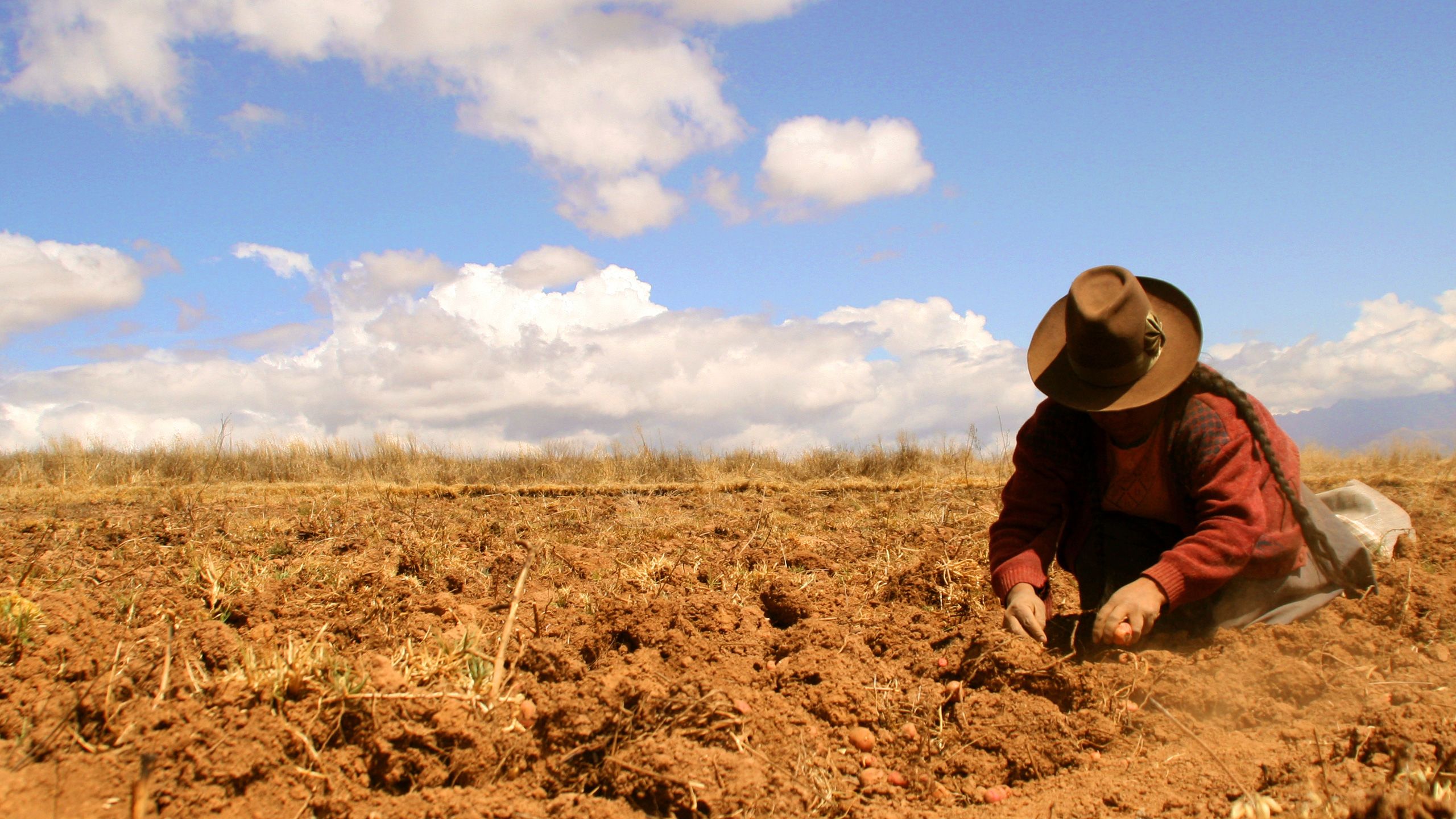

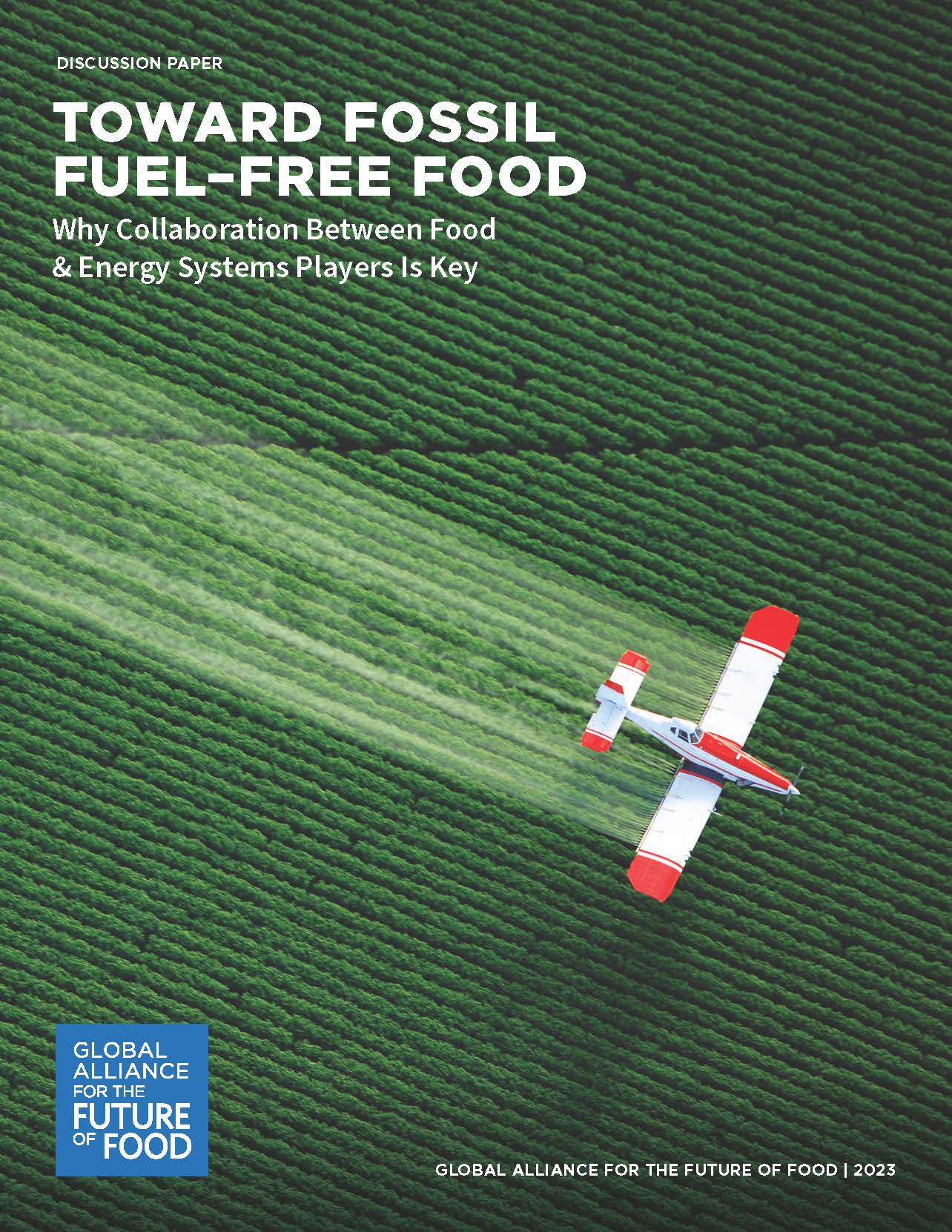
Discussion Paper: Why Greater Collaboration Between Food and Energy Sector Actors Is Key to Reaching 1.5 degrees.
We have written a complementary publication, Toward Fossil Fuel–Free Food: Why Collaboration Between Food and Energy Systems Players Is Key, which delves into the trade-offs, synergies, gaps, and opportunities that arise within the food–energy nexus. In the Discussion Paper, you will find recommendations and near-term opportunities for enhanced coordination and collaboration among policymakers, funders, and advocates working across the food–energy nexus. The emphasis is on identifying measures to reduce fossil fuel usage in food systems.
The aim of this paper is to ignite conversations, encourage collaboration, and foster shared objectives within the food–energy nexus.
Find out more about the Global Alliance for the Future of Food
The research and analysis underpinning this brief was commissioned from Dalberg Advisors by the Global Alliance for the Future of Food.
Copyright © 2023 Global Alliance for the Future of Food. This work is licensed under a Creative Commons Attribution–Non-Commercial 4.0 International License.

